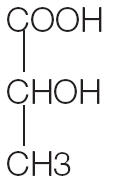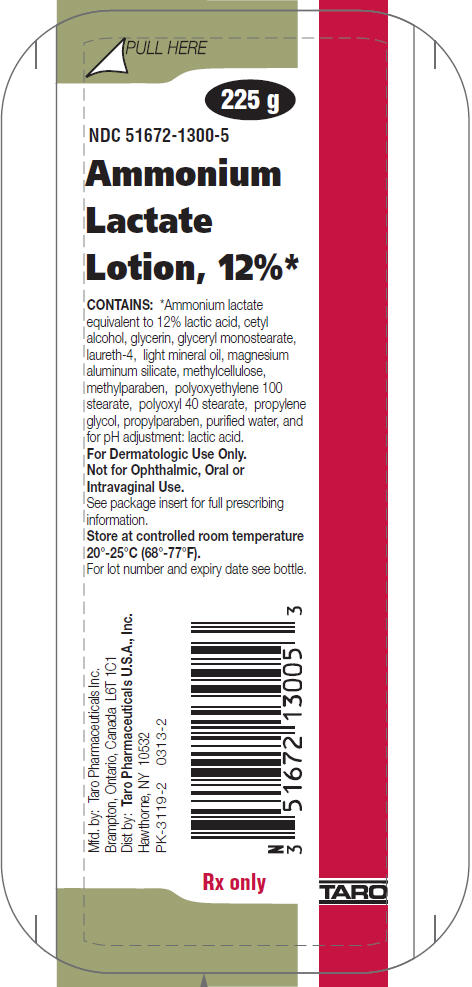Ammonium Lactate by Taro Pharmaceuticals U.S.A., Inc. / Taro Pharmaceuticals Inc. AMMONIUM LACTATE lotion
Ammonium Lactate by
Drug Labeling and Warnings
Ammonium Lactate by is a Prescription medication manufactured, distributed, or labeled by Taro Pharmaceuticals U.S.A., Inc., Taro Pharmaceuticals Inc.. Drug facts, warnings, and ingredients follow.
Drug Details [pdf]
- SPL UNCLASSIFIED SECTION
-
DESCRIPTION
*Ammonium Lactate Lotion, 12% specially formulates 12% lactic acid, as ammonium lactate to provide a lotion pH of 4.5 - 5.5. Ammonium lactate lotion also contains cetyl alcohol, glycerin, glyceryl monostearate, laureth-4, light mineral oil, magnesium aluminum silicate, methylcellulose, methylparaben, polyoxyethylene 100 stearate, polyoxyl 40 stearate, propylene glycol, propylparaben, purified water, and for pH adjustment: lactic acid. Lactic acid is a racemic mixture of 2-hydroxypropanoic acid and has the following structural formula:

-
CLINICAL PHARMACOLOGY
Lactic acid is an alpha-hydroxy acid. It is a normal constituent of tissues and blood. The alpha-hydroxy acids (and their salts) may act as humectants when applied to the skin. This property may influence hydration of the stratum corneum. In addition, lactic acid, when applied to the skin, may act to decrease corneocyte cohesion. The mechanism(s) by which this is accomplished is not yet known. An in vitro study of percutaneous absorption of Ammonium Lactate Lotion using human cadaver skin indicates that approximately 5.8% of the material was absorbed after 68 hours.
- INDICATIONS AND USAGE
- CONTRAINDICATIONS
-
WARNINGS
Sun exposure to areas of the skin treated with Ammonium Lactate Lotion, 12% should be minimized or avoided (see PRECAUTIONS section). The use of Ammonium Lactate Lotion should be discontinued if hypersensitivity is observed.
-
PRECAUTIONS
General
For external use only. Stinging or burning may occur when applied to skin with fissures, erosions or that is otherwise abraded (for example, after shaving the legs). Caution is advised when used on the face because of the potential for irritation. The potential for post-inflammatory hypo- or hyperpigmentation has not been studied.
Information for Patients
Patients using Ammonium Lactate Lotion, 12% should receive the following information and instructions:
- This medication is to be used as directed by the physician, and should not be used for any disorder other than for which it was prescribed. It is for external use only. Avoid contact with eyes, lips, or mucous membranes.
- Patients should minimize or avoid use of this product on areas of the skin that may be exposed to natural or artificial sunlight, including the face. If sun exposure is unavoidable, clothing should be worn to protect the skin.
- This medication may cause transient stinging or burning when applied to skin with fissures, erosions, or abrasions (for example, after shaving the legs).
- If the skin condition worsens with treatment, the medication should be promptly discontinued.
Carcinogenesis, Mutagenesis, Impairment of Fertility
The topical treatment of CD-1 mice with 12%, 21% or 30% ammonium lactate formulations for two years did not produce a significant increase in dermal or systemic tumors in the absence of increased exposure to ultraviolet radiation. The maximum systemic exposure of the mice in this study was 0.7 times the maximum possible systemic exposure in humans. However, a long-term photocarcinogenicity study in hairless albino mice suggested that topically applied 12% ammonium lactate formulations enhanced the rate of ultraviolet light-induced skin tumor formation. The mutagenic potential of ammonium lactate formulations was evaluated in the Ames assay and in the mouse in vivo micronucleus assay, both of which were negative. In dermal Segment I and III studies with ammonium lactate formulations there were no effects observed in fertility or pre- or post-natal development parameters in rats at dose levels of 300 mg/kg/day (1800 mg/m2/day), approximately 0.4 times the human topical dose.
Pregnancy
Teratogenic effects
Pregnancy Category B
Animal reproduction studies have been performed in rats and rabbits at doses up to 0.7 and 1.5 times the human dose respectively (600 mg/kg/day, corresponding to 3600 mg/m2/day in the rat and 7200 mg/m2/day in the rabbit) and have revealed no evidence of impaired fertility or harm to the fetus due to ammonium lactate formulations. There are, however, no adequate and well-controlled studies in pregnant women. Because animal reproduction studies are not always predictive of human response, ammonium lactate lotion should be used during pregnancy only if clearly needed.
Nursing Mothers
Although lactic acid is a normal constituent of blood and tissues, it is not known to what extent this drug affects normal lactic acid levels in human milk. Because many drugs are excreted in human milk, caution should be exercised when ammonium lactate lotion is administered to a nursing woman.
Pediatric Use
Safety and effectiveness of ammonium lactate lotion have been demonstrated in infants and children. No unusual toxic effects were reported.
Geriatric Use
Clinical studies of ammonium lactate lotion 12% did not include sufficient numbers of subjects aged 65 and over to determine whether they respond differently from younger subjects. Other reported clinical experience has not identified differences in responses between elderly and younger patients. In general, dose selection for an elderly patient should be cautious.
-
ADVERSE REACTIONS
The most frequent adverse experiences in patients with xerosis are transient stinging (1 in 30 patients), burning (1 in 30 patients), erythema (1 in 50 patients) and peeling (1 in 60 patients). Other adverse reactions which occur less frequently are irritation, eczema, petechiae, dryness and hyperpigmentation.
Due to the more severe initial skin conditions associated with ichthyosis, there was a higher incidence of transient stinging, burning and erythema (each occurring in 1 in 10 patients).
- OVERDOSAGE
- DOSAGE AND ADMINISTRATION
-
HOW SUPPLIED
225 g (NDC: 51672-1300-5) plastic bottle and 400 g (NDC: 51672-1300-9) plastic bottle.
- SPL UNCLASSIFIED SECTION
-
PRINCIPAL DISPLAY PANEL - 225 g Bottle Label
NDC: 51672-1300-5
LIFT HERE
225 g
Ammonium
Lactate
Lotion 12%*CONTAINS: *Ammonium lactate
equivalent to 12% lactic acid, cetyl
alcohol, glycerin, glyceryl monostearate,
laureth-4, light mineral oil, magnesium
aluminum silicate, methylcellulose,
methylparaben, polyoxyethylene 100
stearate, polyoxyl 40 stearate,
propylene glycol, propylparaben,
purified water, and for pH adjustment:
lactic acid.
For Dermatologic Use Only.
Not for Ophthalmic, Oral or
Intravaginal Use.
See package insert for full prescribing
information.
Store at controlled room temperature
20°-25°C (68°-77°F).
For lot number and expiry date see
bottle.Mfd. by: Taro Pharmaceuticals Inc.
Brampton, Ontario, Canada L6T 1C1
Dist. by:
Taro Pharmaceuticals U.S.A., Inc.
Hawthorne, NY 10532
PK-3119-3 0614-3Rx only
TARO

-
INGREDIENTS AND APPEARANCE
AMMONIUM LACTATE
ammonium lactate lotionProduct Information Product Type HUMAN PRESCRIPTION DRUG Item Code (Source) NDC: 51672-1300 Route of Administration TOPICAL Active Ingredient/Active Moiety Ingredient Name Basis of Strength Strength Ammonium Lactate (UNII: 67M901L9NQ) (lactic acid, unspecified form - UNII:33X04XA5AT) lactic acid, unspecified form 120 mg in 1 g Inactive Ingredients Ingredient Name Strength glyceryl monostearate (UNII: 230OU9XXE4) peg-100 stearate (UNII: YD01N1999R) polyoxyl 40 stearate (UNII: 13A4J4NH9I) laureth-4 (UNII: 6HQ855798J) cetyl alcohol (UNII: 936JST6JCN) light mineral oil (UNII: N6K5787QVP) methylparaben (UNII: A2I8C7HI9T) propylparaben (UNII: Z8IX2SC1OH) water (UNII: 059QF0KO0R) magnesium aluminum silicate (UNII: 6M3P64V0NC) propylene glycol (UNII: 6DC9Q167V3) glycerin (UNII: PDC6A3C0OX) Product Characteristics Color WHITE Score Shape Size Flavor Imprint Code Contains Packaging # Item Code Package Description Marketing Start Date Marketing End Date 1 NDC: 51672-1300-5 225 g in 1 BOTTLE, PLASTIC; Type 0: Not a Combination Product 05/28/2004 2 NDC: 51672-1300-9 400 g in 1 BOTTLE, PLASTIC; Type 0: Not a Combination Product 05/28/2004 Marketing Information Marketing Category Application Number or Monograph Citation Marketing Start Date Marketing End Date ANDA ANDA076216 05/28/2004 Labeler - Taro Pharmaceuticals U.S.A., Inc. (145186370) Establishment Name Address ID/FEI Business Operations Taro Pharmaceuticals Inc. 206263295 MANUFACTURE(51672-1300)
© 2025 FDA.report
This site is not affiliated with or endorsed by the FDA.